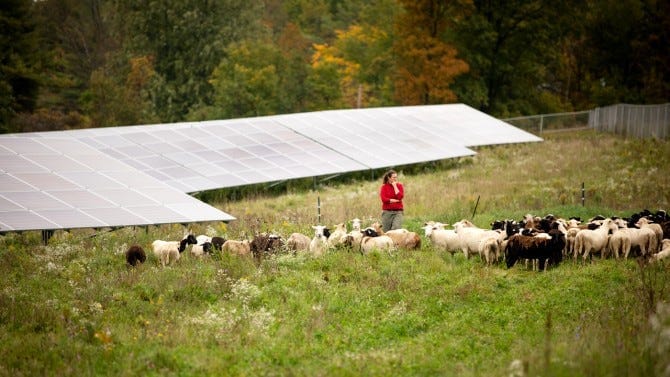Farms vs. solar, bad math, and a very big vote
This week's roundup of climate and energy news, from a slushy outpost of rural upstate New York.

FROM THE EDITOR: Hello, all you beautiful people. This week’s EoD Digest is a blockbuster double issue, since we didn’t run one last week. The full Digest is usually for paid subscribers, but I’m making this one free. Happy merry to you all.
“Wow!” I bet you’re saying to yourself right now. “Look at all this news! You’d have to read dozens of papers to really get what’s going on in the local climate and energy world!” Yes, you would — and if you’re into this stuff, you should subscribe.
I’ve been working behind the scenes this week to set up some future projects and collaborations, and I’m excited about how that’s shaping up. I’ve got some good stories coming your way soon: I had a great chat the other day with the unstoppable Adam Bosch, who recently took the reins at Pattern for Progress, about the buildout of EV chargers across the Hudson Valley and why it’s important for towns to plan ahead. I also had a really good time nerding out with Jeff Hendler of Logical Buildings/Grid Rewards, who is already living in the future, and working on getting the rest of us caught up. More on that soon.
I feel like I’m building the plane while it’s flying here, but that’s how it goes in digital news. I launched this project about a month ago with a hope that some of you might find this stuff interesting. I’m delighted to report that it’s now up to more than 50 paying subscribers, and almost ten times as many free readers. If this keeps up, I’ll be able to afford to subscribe to even more news outlets. Ha.
In 2023, New York’s climate plan begins to go into effect in earnest — and so does a lot of deeply transformational climate policy and funding from the federal Inflation Reduction Act. I intend to be along for the ride, sorting out what it all means for local communities, with your help. Thanks to you all for your support, and for your patience while we sort out the logistics around here. – Ed.
ON THE FARM: Solar buildout on farmland is a very hot topic locally. It’s tough to build anything anywhere right now, especially at the speed and scale needed to hit ambitious climate goals. In rural New York, much of the current controversy around renewable buildout is focused on agricultural land, and on how much say rural towns and communities have over the siting of big projects. Legitimate worries about the impact of solar buildout on farmland and biodiversity are getting mixed up with the near-universal human desire not to have to look at any energy infrastructure anywhere. Poorer rural communities are being targeted for energy buildout, just like they do in cities. “Dark money” from fossil fuel interests is pouring into deceptive faux-environmentalist opposition to renewables and steering the rhetoric in local land use battles. Neighbors are fighting. It’s a mess.
My Times Union colleague Roger Hannigan Gilson has a couple of good stories out this week about state efforts to balance the need to grow food with the need to grow power production. One is about a new bill, introduced by Hudson Valley Assemblywoman Didi Barrett, that seeks to get communities more proactively involved in the project siting process. If passed, it would create a state mapping tool that local officials and other community members could use to locate good project sites, and also create new forums for dialogue between communities and project developers. In the Hudson Valley, the nonprofit Scenic Hudson is already doing that work on the ground, and supporting Barrett’s bill as a way to expand it statewide.
Barrett’s bill was a direct response to the ongoing legal battle over the Shepherd’s Run project in the Columbia County town of Copake, which has major implications for New York’s climate goals, and for communities currently living with deadly fossil fuel power plant pollution. I highly recommend you read Susan Arterian’s deep-dive story about that project last September, “The Backyard Battle for New York’s Climate Future,” which I helped edit, and which all of us at The River were very proud of.
Roger also has a story about a new state law, signed by Gov. Kathy Hochul last week, that requires the fees solar developers pay to the state to be put toward a new fund for farmland preservation. This bill also came from the Hudson Valley: It was sponsored by state Senator Michelle Hinchey, a Saugerties Democrat who chairs the state Senate’s agricultural committee.
DEEP SIGH: The Woodstock Times, a paper I love a whole lot, got it spectacularly wrong in a story about Hinchey’s farmland protection funding bill. The reporter cites a NYSERDA figure of 118.3 megawatts of solar power currently built in the county, then writes this:
“With the average electricity usage of an Ulster County consumer over the course of the entire year averaging around twelve megawatts and the United States Census Bureau estimating over 85,000 homes in Ulster County, it’s safe to total assume usage higher than a million megawatts, even leaving out commercial properties and car-charging stations.”
Oh no, you guys. Just no. This is not how to do energy math.
The average yearly household electricity use in New York is about 12,000 kWh — that stands for “kilowatt hours,” and you can’t just do some easy math to convert that number to megawatts, because they’re measuring different things. Megawatts are a measure of capacity, not energy consumption. A 12-megawatt power plant running at peak output would generate 12,000 kilowatt hours of usable electricity every hour — enough to power thousands of homes.
Calculating how much capacity you’d need to serve Ulster County gets even more complicated when you consider that no power plant runs at full output 100 percent of the time. Different power generation technologies have different “capacity factors,” which is a measure of how often the power plant runs at full output. For a solar installation in upstate New York, the capacity factor is pretty low: about 13 percent. Nuclear has the highest capacity factor, at more than 92 percent. Natural gas, which currently makes up about half of New York State’s electricity production, is somewhere in the middle at about 54 percent.
Energy use fluctuates too — and when demand spikes, the grid must be able to deliver it immediately. That means the grid needs enough installed capacity to keep up with demand at the peaks, not just the average.
So how much capacity buildout does Ulster County need to keep up with the demand from 85,000 homes? The answer is it depends — on technology, on weather, on transmission infrastructure, on the spikiness and timing of local demand peaks, and on how quickly residents are switching from fossil fuels to heat pumps and electric vehicles. If you’re interested in this stuff, NYISO’s annual reports on the state of the grid make for eye-opening reading.
I’m not here to bash a local paper. Energy is a tough beat, and local reporters and editors are stretched thin. But stating that it would take more than a million megawatts of installed solar to cover Ulster County’s household energy use? I don’t know what the exact right number is, but that number is very wrong. And to a reader who might be freaked out by a five-megawatt solar farm starting up nearby, that’s a deeply alarming wrong number. Try to come correct out there.
MIXED BAG: Remember when West Virginia Senator Joe Manchin shocked the nation back in August by actually supporting an ambitious federal climate bill? And then that bill, the Inflation Reduction Act, actually passed? Well, Manchin got a pound of flesh out of Senate Majority Leader Chuck Schumer for that, in the form of a promise of support for “permitting reform” that benefits both the fossil fuel industry and clean-energy transmission projects.
Manchin’s permitting reform effort died yet another death in Congress this week, as an amendment tacked onto a defense spending bill attracted a handful of Republican yes votes but not enough to offset a slightly larger block of Democratic nays. The bill may return in another form next year, The Hill reports.
If you’re a climate advocate, how you feel about the failure of Manchin’s side deal probably depends on what kind of problems you work on. Environmental justice advocates representing frontline communities hit hard by pollution are celebrating the end of Manchin’s “dirty deal,” which would have forced a greenlight on the Mountain Valley Pipeline natural gas project. Energy experts who work on transmission are more glum about it: Many of them are worried that without permitting reform in that realm, the transition away from fossil fuels for the power grid will be impossible. And next year, with a Republican House, legislative action on transmission gets a lot harder.
IT’S UP TO YOU, NEW YORK: On Monday, the state Climate Action Council will take a very big vote: They’re finalizing New York’s scoping plan for decarbonizing the economy over the next few decades. It’s a big, complicated document, and as of a week ago, they were still arguing over the details.
Two things I’m keeping an eye on:
-The language around hydrogen and “renewable natural gas,” which have been a flashpoint for controversy throughout the planning process, right up to their most recent meeting. The natural gas industry is pushing for greater roles for these fuels in the plan, because reliance on them gives the industry more arguments for maintaining its network of pipelines and gas infrastructure. The trouble with that logic: Hydrogen isn’t gas, it doesn’t behave nicely in infrastructure built for natural gas — and there isn’t remotely enough “renewable natural gas” being captured from landfills and farms to replace our current use of fossil natural gas.
-Potentially, a new piece of the plan calling on the state DEC to enact a “cap-and-invest” program, which did not appear in the draft scoping plan released in 2021. What is “cap-and-invest,” you might ask? It sounds a lot like “cap-and-trade,” doesn’t it? Yes it does — and here’s Colin Kinniburgh of NY Focus to break it down for us.
THE FOOD IS AWFUL, AND SUCH SMALL PORTIONS: The final state climate scoping plan isn’t out yet, but the usual suspects are already lining up to bash it. It goes too far! It doesn’t go far enough! Welcome to the fun world of making climate policy, a fearsomely complicated project that tends to attract a lot of heat from both the right and the left.
Council members of New York’s biggest city have, of course, weighed in on what they’re looking for in the state’s climate plan: mainly, for it to play nicely with New York City’s ambitious local law limiting emissions from large buildings.
POWER TO THE PEOPLE: Most New Yorkers are in favor of the Build Public Renewables Act, according to a survey conducted by the left-leaning pollsters at Data For Progress — although, as City & State reports, most of those polled had never heard of the bill before the survey, and the pollsters asked a few leading questions. The bill is a complicated piece of business, but mainly it would empower and direct the New York Power Authority to compete with private developers on building renewable power.
HUBBA HUBBA: New York’s ten economic development regions, which we all got very tired of looking at PowerPoint slides of during the endless Cuomo pandemic road show, are all getting “clean energy hubs” that will serve as centers for public outreach and education on the clean energy transition. Hochul’s office announced $52 million in awards for the hubs last week to local nonprofits that are heading them up.
In and around the Catskills, Cornell Cooperative Extension is taking on the lion’s share of the work: County CCE offices are heading up the clean energy hubs for the Mid-Hudson Valley, Southern Tier, and Mohawk Valley economic development regions, each of which contains a chunk of Catskills territory. In the Capital District, which includes Greene County, the clean energy hub will be led by the Albany-based Affordable Housing Partnership.
My $0.02: I’m very interested to see what these hubs will do, and what resources they’ll have to guide people and local governments through a complicated mess of challenges and opportunities created by the clean energy transition. I’m also skeptical that they’ll be good at serving the rural areas on the outskirts of the state economic development regions, which tend to get short shrift in all sorts of things related to regional economic development. We’ll see.
RUNNING TOWARD FIRES: Squeezed hard by housing costs, Americans are moving toward areas of high climate-change-driven wildfire risk, not away, Inside Climate News reports. Not discussed in this story: The risk of flood, which is the main driver of climate-related risk here in the wetter Northeast.
MESSING WITH TEXAS: The Lone Star State’s abortion bounty law, which gives private citizens cash incentives to bring lawsuits against abortion providers, has spawned a lot of legal weirdness in both red states and blue since its 2021 passage. The latest: New York state Senator Zellnor Myrie, a Democrat, is taking a page from the Texas legal playbook with a proposed bill that would enable private citizens to sue fossil fuel companies, Politico powerhouse Marie French reports.
OVERHEARD: “If we really follow [New York State climate law] guidance, it is physically impossible to make hydrogen from fossil gas.” – Robert Howarth, biogeochemist, Cornell professor, and member of the New York State Climate Action Council, at the CAC’s December 5 meeting.
COMING UP: Climate stuff on the calendar.
12/19: The Climate Action Council takes their big vote at a 1pm meeting.
TWO CENTS: Spare change from the couch cushions of social media.
EDITOR’S NOTE: Got news tips? Stories we should be discussing in class? Thoughts on what would make this newsletter more useful to you? Talk to me: empireofdirt@substack.com.


